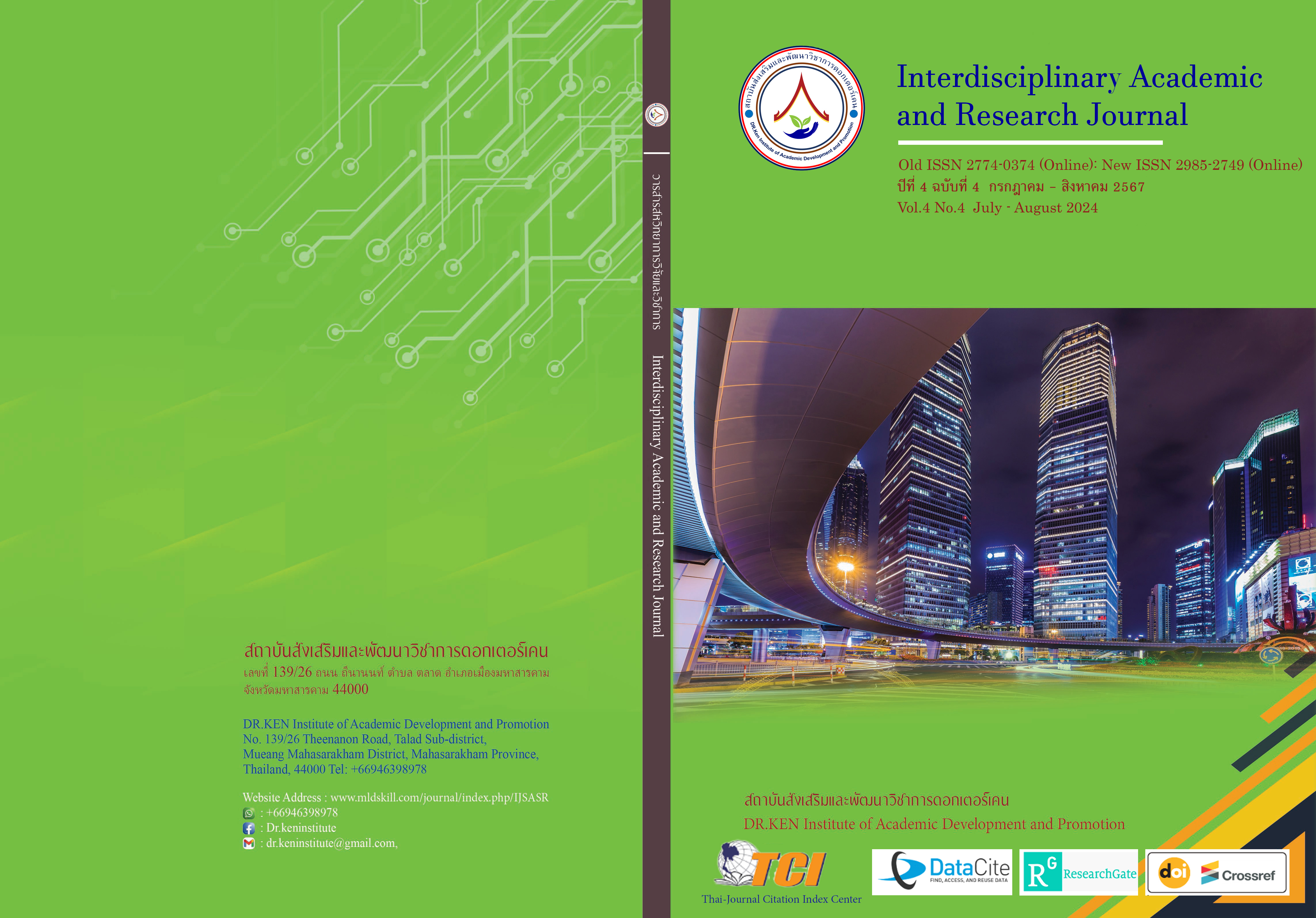Desirable Leadership of School Administrators in the Digital Era under The Secondary Educational Service Area Office Nonthaburi
DOI:
https://doi.org/10.60027/iarj.2024.277176Keywords:
Desirable Leadership; , School Administrators;, Digital era; , Secondary Educational Service Area Office NonthaburiAbstract
Background and Aims: Desirable Leadership is the expectation or demand for school administrators to have characteristics, concepts, and visions in the digital era including creating an organization that supports the use of technology to develop and improve the school management, and learning and teaching of teachers. The objectives of this research were 1) to study the desirable leadership of school administrators in the digital era, and 2) to compare the opinions of teachers on the desirable leadership of school administrators in the digital classified by gender, age, education level, work experience, and school size.
Methodology: The sample consisted of 315 teachers under The Secondary Educational Service Area Office Nonthaburi using stratified random sampling according to school size. The research instrument was a questionnaire with content validity, IOC values between .67-1.00, and a reliability value of .90. The data were analyzed by using frequency, percentage, mean, standard deviation, t-test, One-way ANOVA, and LSD.
Results: The results of the research were as follows: 1) the desirable leadership of school administrators in the digital era was at the highest level in overall, and particular aspects, ranking from the highest to the lowest mean: Encouragement the Use of Technology in Teaching, Ethics in Using Technology, Vision, and Management with Technology, and 2) the opinions of teachers on the desirable leadership of school administrators in digital era classified by gender, education level, work experience, and school size were not different, while the differential age was statistically significant at the level .01 and .05.
Conclusion: The research results indicated the desired leadership of school administrators in the digital era, in overall and particular aspects. The highest mean was “Encourongement the
Use of Technology in Teaching”, and the lowest mean was “Management with Technology”, while teachers' opinions classified by the differential gender and education level, work experience, and school size were not different.
References
เกียรติศักดิ์ ลำพองชาติ. (2563). ทักษะการทำงานในโลกยุคดิจิทัล. กลุ่มงานติดตามและประมวลผลงานของวุฒิสภา สำนักวิชาการ: สำนักงานเลขาธิการวุฒิสภา.
ณัฏฐณิชา พรปทุมชัยกิจ. (2564). ภาวะผู้นํายุคดิจิทัลของผู้บริหารสถานศึกษาสังกัดสํานักงานเขตพื้นที่การศึกษามัธยมศึกษา ศรีสะเกษ ยโสธร. วิทยานิพนธ์ครุศาสตรมหาบัณฑิต มหาวิทยาลัยราชภัฏศรีสะเกษ.
รัตนาภรณ์ วัชรอัตยาพล. (2563). ตัวบ่งชี้ภาวะผู้นำทางเทคโนโลยีของผู้บริหารสถานศึกษาในสังกัดกรุงเทพมหานคร. ดุษฎีนิพนธ์ศึกษาศาสตรดุษฎีบัณฑิต การบริหารการศึกษา มหาวิทยาลัยมหามกุฏราชวิทยาลัย.
โรจนศักดิ์ อินทนน. (2566).ภาวะผู้นำของผู้บริหารในยุคดิจิทัลที่ส่งผลต่อประสิทธิผลการบริหารงานโรงเรียน สังกัดสำนักงานเขตพื้นที่การศึกษามัธยมศึกษาสกลนคร. วิทยานิพนธ์ครุศาสตรมหาบัณฑิต สาขาวิชาการบริหารการศึกษา : มหาวิทยาลัยราชภัฎสกลนคร
สำนักงานเขตพื้นที่การศึกษามัธยมศึกษานนทบุรี. (2566). ข้อมูลสารสนเทศ ปีการศึกษา2565. Retrieved on 12 July 2023, from: https://www.spmnonthaburi.go.th/main/news/11658.html.
สุกัญญา แช่มช้อย. (2561). การบริหารสถานศึกษาในยุคดิจิทัล. กรุงเทพฯ : โรงพิมพ์แห่งจุฬาลงกรณ์มหาวิทยาลัย.
สุจรรยา ขาวสกุล, ธีระ รุญเจริญ และ วรสิทธิ์ รัตนวราหะ. (2560). ผู้บริหารสถานศึกษายุคดิจิทัล. ในรายงานสืบเนื่องการประชุมวิชาการและการนำเสนอผลงานวิจัยระดับชาติครั้งที่ 3, 138-148. กรุงเทพฯ: มหาวิทยาลัยหอการค้าไทย.
Cronbach, L.J. (1990). Essentials of psychological testing. 5th edition. New York : Harper Collins Publishers.( pp.202-204)
ISTE. (2021). Standards for Administrators (Permitted Educational Use). Retrieved October 6, 2023. https://www.scribd.com/document/359271182/ISTE-Standards-for-Administrators
Kaganer, E., Sieber, S., and J. Zamora. (2014). The 5 Keys to a Digital Mindset. IESE. Retrieved December 2023 from: http://www.forbes.com/sites/iese/2014/03/11/the-5-keys-to-a-digital-mindset/2/#47c6c5 e94f5f.
Krejcie, R.V., & D.W. Morgan. (1970). “Determining Sample Size for Research Activities”. Educational and Psychological Measurement. 30(3), 607 – 610.
Sheninger, E. (2014). Digital leadership: Changing paradigms for changing times. Thousand Oaks: CA: Corwin Press.
Stewart, M. (2015). The Language of Praise and Criticism in a Student Evaluation Survey. Studies in Educational Evaluation, 45, 1-9.
Tran, L. (2017). Digital Transformation: The 5 Must-Have Skills for Digital Leaders. Retrieved from: https://www.inloox.com/company/Blog/articles/digital-transformation-the-5-must-have-skills-for-digital-leaders/.
Weserman, G. (2018). Common Traits of the Best Digital Leaders. Retrieved January 5, 2024, from https://sloanreview.mit.edu/article/common-traits-of-the-best-digital-leaders/.
Downloads
Published
How to Cite
Issue
Section
License
Copyright (c) 2024 Interdisciplinary Academic and Research Journal

This work is licensed under a Creative Commons Attribution-NonCommercial-NoDerivatives 4.0 International License.
Copyright on any article in the Interdisciplinary Academic and Research Journal is retained by the author(s) under the under the Creative Commons Attribution-NonCommercial-NoDerivatives 4.0 International License. Permission to use text, content, images, etc. of publication. Any user to read, download, copy, distribute, print, search, or link to the full texts of articles, crawl them for indexing, pass them as data to software, or use them for any other lawful purpose. But do not use it for commercial use or with the intent to benefit any business.
















.png)


